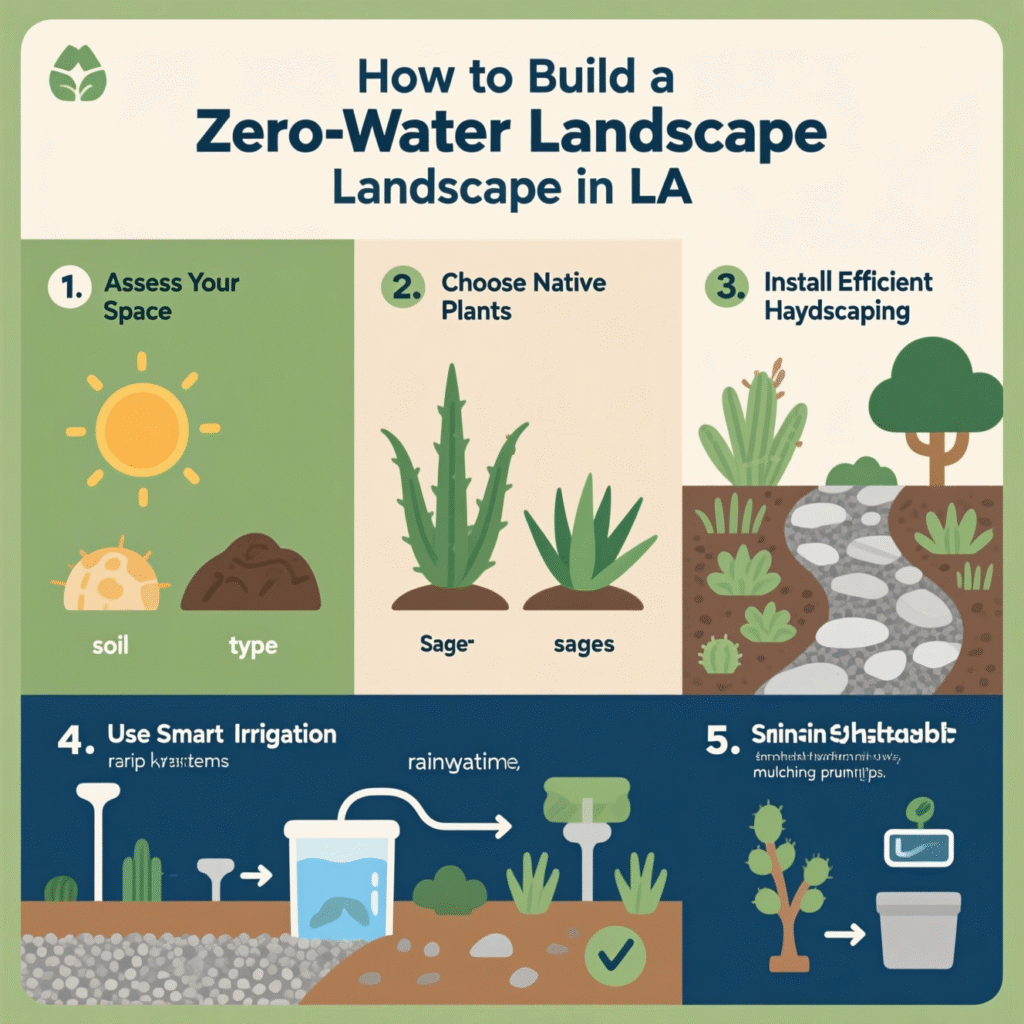Los Angeles homeowners are facing one of the most pressing challenges of modern living: how to create a beautiful yard while conserving water. With ongoing drought conditions, stricter water regulations, and the rising cost of utilities, landscaping has shifted from lush lawns and thirsty plants to sustainable, zero-water designs. A zero-water landscape, also called xeriscaping, is about building an outdoor environment that thrives without relying on irrigation systems or regular watering.
Table of Contents
ToggleTable of Contents
For LA homeowners, this approach not only saves money and resources but also adds curb appeal and long-term value to the property. Designing such a landscape requires thoughtful planning, the right choice of materials, and a deep understanding of California’s natural ecosystem.
Why Zero-Water Landscaping Matters in Los Angeles
Water scarcity is not a temporary issue for Southern California—it’s a long-term reality. Traditional lawns consume thousands of gallons of water annually, straining both local resources and homeowner budgets. A zero-water yard eliminates that dependency while aligning with California’s sustainability goals.
Beyond water savings, zero-water landscaping provides additional benefits. It lowers maintenance needs, supports biodiversity by using native plants, and keeps outdoor spaces usable during extreme weather. For hillside or modern urban homes in LA, it’s also a chance to express creativity through contemporary, eco-friendly design.
Step 1: Start with Smart Design Planning
The first step in building a zero-water landscape is creating a design that matches the property’s layout and microclimate. Unlike traditional gardens, every feature in a zero-water yard should serve a purpose—whether it’s for beauty, shade, or erosion control.
Work with the natural contours of your yard instead of fighting them. If your property is sloped, consider terraces or retaining walls that minimize runoff. For urban backyards, opt for compact, multifunctional designs that make the most of limited space.
Step 2: Replace Grass Lawns
One of the biggest water guzzlers in LA yards is the lawn. To achieve a true zero-water landscape, replacing grass is essential. Options include:
- Artificial turf: A popular choice for homeowners who want the look of grass without the water needs.
- Gravel and stone ground covers: These provide texture, durability, and excellent drainage.
- Hardscape features: Concrete, decomposed granite, or pavers can transform spaces into patios, walkways, or seating areas.
By eliminating grass, homeowners can save up to 50 gallons of water per square foot each year.

Step 3: Choose California Native and Drought-Tolerant Plants
A zero-water landscape doesn’t mean sacrificing greenery. Native California plants thrive naturally in LA’s climate without supplemental watering once established. Popular choices include succulents, cacti, sage, lavender, agave, and manzanita.
For structure, use ornamental grasses or desert shrubs that can handle hot summers. By blending different textures and colors, homeowners can create visually striking gardens that are both low-maintenance and water-independent.
Step 4: Incorporate Hardscaping and Outdoor Living
In LA, outdoor living is a way of life. Instead of lawns, consider expanding usable space through hardscaping elements. Patios, fire pits, pergolas, and built-in seating areas reduce water needs while increasing functionality. Stone pathways and decorative boulders also add character and blend well with desert-inspired aesthetics.
A well-designed zero-water yard feels intentional and luxurious, not barren. Combining sleek modern lines with natural desert textures creates a stylish, livable environment.
Step 5: Use Smart Mulching and Soil Solutions
Even in a zero-water yard, soil management is critical. Mulch helps retain moisture in the ground, reduces weeds, and regulates temperature around plant roots. Organic mulch like bark or wood chips complements natural plantings, while gravel mulch works well in modern, minimalist designs.
For areas with compacted soil, incorporating sand or decomposed granite improves drainage, ensuring plants thrive naturally.
Step 6: Add Sustainable Features
A zero-water yard can be elevated by integrating eco-friendly features such as:
- Solar-powered outdoor lighting for energy efficiency.
- Rainwater catchment systems (for gray water use on non-landscape features).
- Permeable pavers that allow rainwater to seep back into the ground.
These details ensure the landscape contributes positively to sustainability while enhancing functionality.
Step 7: Embrace Minimalist Design Principles
A zero-water yard often shines when it follows minimalist design. Instead of overcrowding the space with too many elements, focus on open layouts, bold focal points, and natural symmetry. Large potted plants, geometric stone paths, or a single sculptural tree can create drama without requiring constant upkeep.
In Los Angeles, this aligns perfectly with modern architectural styles, which favor clean lines and functional outdoor living.
The Costs of Zero-Water Landscaping in LA
The cost of building a zero-water landscape in Los Angeles varies widely depending on size and design. A full replacement of a lawn with gravel, native plants, and minimal hardscaping can range from $8,000 to $20,000, while more elaborate designs with built-in seating, custom lighting, and luxury finishes may cost $25,000 to $50,000.
Although the upfront cost can be significant, the return on investment is clear. Homeowners save on water bills, lawn maintenance, and gain long-term property value. Many LA neighborhoods also offer rebates for turf removal, which can significantly offset the initial expense.

Long-Term Benefits of Zero-Water Landscaping
Zero-water landscapes are not just about aesthetics; they are part of a long-term strategy for resilient living in Los Angeles. Benefits include:
- Lower water bills and reduced utility costs.
- Minimal maintenance compared to traditional lawns.
- Increased property value through sustainable design.
- Aesthetic appeal that matches LA’s modern desert-inspired architecture.
- Contribution to California’s water conservation efforts.
Final Thoughts
Building a zero-water landscape in Los Angeles is about much more than saving water—it’s about creating an outdoor space that is functional, sustainable, and stylish. By replacing grass lawns, choosing drought-tolerant plants, integrating hardscaping, and focusing on sustainable features, homeowners can enjoy a yard that thrives in LA’s climate while reducing their environmental footprint.
As California continues to embrace eco-conscious living, zero-water landscaping isn’t just a passing trend—it’s the future of outdoor design. For homeowners planning their next yard transformation, this approach ensures that beauty and responsibility go hand in hand.


